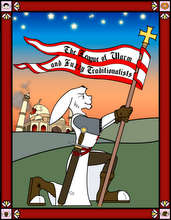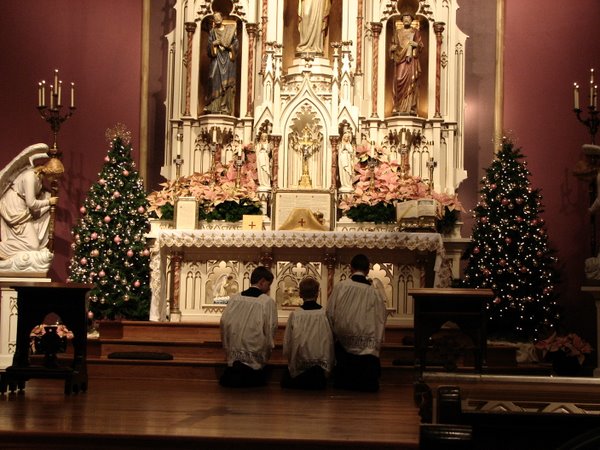
The Doctrinal Statement on the Brown Scapular of Our Lady of Mount Carmel
The following is the approved English text of the doctrinal section of the "Rite of Blessing of and Enrollment in the Scapular of the Blessed Virgin Mary of Mount Carmel" as issued and confirmed by the Congregation for Divine Worship and for the Discipline of the Sacraments, November 29, 1996, Prot. 2243/96/L.
I. HISTORICAL PROFILE
1. Devotion to Our Lady of Mount Carmel is bound to the history and spiritual values of the Order of the Brothers of the Blessed Virgin Mary of Mount Carmel and is expressed through the scapular. Thus, whoever receives the scapular becomes a member of the order and pledges him/herself to live according to its spirituality in accordance with the characteristics of his/her state in life.
A Marian Plan for Evangelical Life
2. The Order of the Brothers of the Blessed Virgin was born on Mount Carmel, in the Holy Land, in the twelfth century. A group of hermits who came from the west settled there to live after the example of Christ in his land. At their request, the Patriarch Albert gave them a rule of life that demanded of them, among other things, to build an oratory among their cells, where they could gather for the celebration of the Eucharist.1 They dedicated the oratory to Mary, and thus they were meant to bind themselves to her in a special way, so that they were identified, at first by the people, and later officially, as the "Brothers of the Blessed Virgin Mary of Mount Carmel".
Thus, the matter in which the Carmelites follow the gospel takes on a deeply Marian character. Mary:
* magnifies the Lord and exults in the wonders of his merciful love (cf. Lk 1:49);
* listens to and ponders in her heart all the things concerning Jesus (cf. Lk 2:19, 51);
* identifies herself with her people, especially those in need, the spirituality and materially poor, the marginalized (cf. Lk 1:52-53ff, Jn 2:3); and
* is constant in prayer, open to the fire of the Spirit (cf. Acts 1:14; 2:1-4) who is the strength of all apostolic gifts.
In the Fraternity of Carmel
3. From of old, they were faithful who were attracted by this ideal way of life and its characteristics and asked to be able to share in it. Their circumstances as family people who lived in the world were no obstacle to their sharing in the fraternity of Carmel.
The visible sign of reception to this fraternity was the habit (or part of the habit) of the order. At first the special sign was the mantle, but soon after it became the scapular.
The scapular of Carmel, or the habit (also called by other names in different places), is one of the devotions most loved by the people of God. The great diffusion of the scapular seems to have been due to the tradition of a vision of Our Lady, documented at least since the end of the fourteenth century.
4. During one of its difficult times, the order asked to get full recognition an stability within the Church. Mary, Patroness of Carmel, seemed to have answered this plea with a vision to the English Carmelite, St. Simon Stock. She held in her hand the scapular and assured the holy prior general, saying:
"This is a privilege for you and the order: whoever dies wearing this Scapular will be saved."2 Later it was widely believed that the Virgin would deliver from Purgatory, on the first Saturday after death, the Carmelites and people associated with them who observed chastity according to their state, recited prayers, and wore the habit of Carmel. This is the so-called Sabbatine Privilege.3
The faithful then quickly understood that to wear the habit meant to enter into the fraternity of the order and of Mary. By responding to the love of the Virgin, they lived secure under her protection in all the dangers of life and, at the hour of death, confident that even after death she would intervene on their behalf, she who "with her maternal love takes care of the brothers of her Son…until they are led to the blessed land."4
More recently, thanks to a deeper understanding of our tradition and the fruit of research and of the process of renewal in the whole Church, the approach to popular devotions and, therefore, to the scapular, has changed.5
5. As a result of the history and evolution of devotion to Mary through the scapular, there are today several categories of devotees according to the degree of identification with and affiliation to the family of Carmel. These may be listed as follows:
a) The religious men and women.
b) The Secular Order (also called Third Order).
c) Those who belong to the Confraternity of the Scapular.
d) All those who receive the scapular and live according to its spirituality in various degrees of association with the order.
e) Those who receive the scapular and live according to its spirituality, but have no formal association with the order.6
f) All who are committed to put into practice the Marian characteristic of Carmelite spirituality wholly and fervently, but in forms which correspond to the nature of the bond that ties them to the family of Mary.7
II. Nature and Character
6. "The scapular is essentially a habit. Whoever receives it, is, by virtue of such reception, associated more or less intimately with the Order of Carmel."8 The scapular or habit is, in fact, a habit in miniature of the order that, in order live "in allegiance to Jesus Christ,"9 has chosen the spiritual experience of familiarity10 with Mary, sister, mother, and model.
7. Association with the Carmelite family and familiarity with Mary take on a character that is fundamentally communitarian and ecclesial, because Mary "help all her children - wherever and whenever - to find in Christ the way to the house of the Father."11 Thus the scapular is the small "sign" of the great ideal of Carmel: intimacy with God and friendship among the disciples.
Biblical Symbolism
8. In the Old Testament, a habit - especially a mantle - was the symbol of divine benefits, of protection from on high, of power transmitted to one of God's messengers.
The special coat of Joseph was symbol of predilection (cf. GN 37:3); the gift of Jonathan's mantle to David was a symbol of friendship (1 Sam 18:4). In Isaiah w read: "I exult for joy in Yahweh, my soul rejoices in my God, for he has clothed me in the garments of salvation, he has wrapped me in the cloak of integrity" (Is 61:10). When the prophet Elijah was taken up to heaven, his mantle fell on his disciple Elisha, thus passing on to him the spirit of the master (cf. 2 Kings 2:14ff).
9. In the New Testament, even the hem of the cloak of Jesus, if touched with faith, communicated his healing power (cf. Mk 5:25ff). St. Paul more than once talks of life in Christ in terms of putting on Christ (Rm 13:14; Ga 3>27); to put on the same attitude as Jesus, that is, the life of filial grace of the Christian, is described by the image of clothes. the religious habit, of which the scapular is a part and symbol, signifies, in a special way, this following of Jesus.
In the Trinity with Christ
10. Mary, the blessed among women, is the masterpiece of the Most Blessed Trinity who united her to Itself, bringing the feminine to its greatest possible realization in her, like an icon of the Trinity's tenderness, and Its saving will.12 Mary is the Lady in whom "all is related to Christ and all depends on him; foreshadowing the Son, God the Father, from all eternity, chose her to be the all holy Mother and adorned her with gifts of the Spirit, granted to no one else."13 Our Lady is for the whole Church the model of that "praise of the glory of the Most Blessed Trinity" to which we are all called to be.
11. The scapular is a symbol of filial and grateful recognition of the mission that the Most Blessed Trinity willed to confide to Mary in the history of salvation, "mystery of mercy" (1 Tim 3:6). These truly significant words were placed on the lips of Mary: "I bring you a scapular as a sign of my blessing and my love and, at the same time, as a sign of the mystery, which will be accomplished, in you. I come to fully 'clothe you in Jesus Christ' (Gal 3:27) so that you may be 'rooted in him' (Col 2:7), 'the royal way', in the depths of the abyss, with the Father and the Spirit of love."14
Ecclesial Journey-Pilgrimage
12. Through space and time, and especially through the history of human kind, Mary is present as "she who has believed" (cf. Lk 1:45), as she who goes forward on the pilgrimage of faith, partaking in the mystery of Christ above all other creatures.15
13. The Church on her faith pilgrimage finds its best model in Our Lady. The example of the Blessed Virgin leads the faithful to conform themselves to the Son. But it also leads them to celebrate the mysteries of Christ with the profound attitude that the Virgin had when she was by her Son at his birth and at the Epiphany, at his death and resurrection. That is, it urges them to guard zealously the Word of God to meditate on it lovingly; to praise God with exultation and to thank him joyfully; to serve God and neighbor faithfully and to offer generously for them even life itself, to pray to the Lord perseveringly and to implore confidently; to be merciful and humble; to "wait vigilantly for the coming of the Lord."16
14. Carmel has followed this way, suggesting to its members to become like Mary in order that, following her example, they may dwell in the divine intimacy. The three phases of this ascent of Mount Carmel are: imitation, union, and likeness to Mary.17
III. Commitment to a Way of Life
15. The following of Chris and of Mary, as understood and lived in the charism of the Order, becomes the reality after which the faithful in the Carmelite family strive. They can rely on the help and support of all the brothers and sisters who share in the same ideal. The members of the Carmelite family live their commitment in various ways: in the "desert", in fraternal life, in the apostolic life, on the streets of the world, working with Mary for the Kingdom of Christ.
16. The institutional forms, erected and acknowledge by the Order, help to emphasize the communal character of the family of htose who, led bye the Spirit, want to dedicate their whole life in this world - in union with Mary - to the glory of God.
Thus, becoming part of the fraternity of the Order of the Brothers of the Blessed Virgin Mary of Mount Carmel and receiving the scapular as a sign of such membership, is for the faithful an instrument of Christian life with special characteristics:
a) To live as "brothers" or "sisters" of Mary in communion with Carmel, to enter more deeply into its spirit, to live its ideals and its history, praying and cooperating with it in order that, faithful to its charism and their vocation, they may reflect, in the world, Mary who brings Jesus to all.
b) To give to Mary ever more space in their life, seeking to live in their circumstances their fidelity to Christ in the spirit of Mary:
- in the faith that gazes at and prays to God, welcomes and dialogues with him;
- in the hope that transforms itself into being at the service of All, which is God; and
- in the charity that abandons itself to the will of the Lord in order to be a true gift to the brothers and sisters, especially the smallest and most humble.
c) To imitate the "praying Virgin" who "kept the word of God in her heart" (cf. Lk 2:19,51), setting aside some time to meet God in prayer, meditating on the mysteries of salvation, taking part in faith in the liturgy of the Church, especially the Eucharist, reciting every day some liturgical hour or some psalms or the holy rosary. To see to it that living in the presence of the living God, every aspect of life becomes prayer and that prayer becomes life, at the same time remembering the obligations and work of their state of life.
d) To share in the Paschal Mystery of Christ by means of voluntary penances, lived in the spirit of Carmel, looking at Mary, whose soul was pierced by a sword (cf. Lk 2:35), who "sustained her union with her Son faithfully even to the cross, where she stood (cf. Jn 19:25) suffering deeply with her Firstborn and uniting herself to his sacrifice."18
e) To show the love of God. The "Most Pure Virgin" allows the love of God to shine through all her being without any resistance or opacity, a love which clothes her personally and opens her to the whole of humanity. Thus, she charms and attracts the devout, who keep their heart and senses, their body and soul, open to the love of God, whom they seek and desire in all things and above all things. The faithful open themselves to receive all the gifts of holiness that God himself places in human relationships and in the love of neighbor. Thus love involves the human body as the "dwelling place" of God (cf. 1 Col 3:16-17), and through which they communicate with others. It is the vehicle for the expression of love.
f) To engage in the works of evagelization. Those who wear the scapular identify themselves with the mission of Carmel to be in the world a prophetic sign of union with God, to work for the coming of the Kingdom of God through visible signs of sharing, reconciliation, justice, looking after the sick, and listening to the cries of the poor.
g) As much as possible, to foster fraternal communion among the members of the fraternity by means of assemblies and reunions, which nourish and support these aims.
17. The scapular is the sign of the love of Mary, icon of the goodness and mercy of the Most Blessed Trinity. This love is the fruit of the grace of God poured into the hearts of the faithful who, in turn, commit themselves to it.
18. Appendix: Practical Norms for the Scapular Confraternity
1) The scapular confraternity of Carmel is an association of the faithful who strive for the perfection of charity in the world in the spirit of the Carmelite Order, participate in the life of the Order and its spiritual benefits in an intimate communion of thought, ideals, and works together with Mary.
2) The supreme moderator of the Carmelite Order is the competent authority for the canonically established of a confraternity. For churches belonging to the Order, the consent given by he ordinary for the canonical establishment of the religious house is also valid for the canonical establishment of the confraternity. However, for the canonical establishment of the confraternity19 in other churches or places, the written consent of the ordinary is required.20
3) A person given authority to act in the name of the Order may receive people into the confraternity of the scapular.
4) Reception into the confraternity takes lace according to the proper rite approved by the Holy See by means of enrollment in the scapular. The scapular consists of two brown or dark pieces of material joined together by two ribbons or pieces of string. For receptions, the name of the faithful and the date must be registered in a book kept for the purpose. These conditions, however, may be waived.
5) After the reception of the scapular, the faithful may substitute it with a medal showing on one side the Sacred Heart of Jesus and on the other Our Lady. Both scapular and medal may be replaced without having to be blessed again.
6) The members of the confraternity must at all times devoutly wear the scapular or the medal as a visible sign of their belonging to Mary in the brotherhood of Carmel.
7) Members are bound to set aside regularly time to be with God in prayer, frequent participation in the Eucharist, daily recitation of one of the hours of the liturgy or of some psalms or the rosary or other equivalent prayers.
8) If possible, they will meet periodically to build up the sense of fraternity, to study the spirit of Carmel, to care for brothers and sisters in need, all in union with Mary.
9) They may gain plenary indulgences, provided they fulfill the usual conditions,21 on the day they join the confraternity and on the following feasts: the Blessed Virgin Mary of Mount Carmel (July 16), St Elijah, prophet (July 20), St Simon Stock (May 16), St Therese of the Child Jesus (October 1), St Teresa of Jesus (October 15), All Carmelite Saints (November 14), and St John of the Cross (December 14).22
10) The solemn feast of the confraternity is that of the Commemoration of the Blessed Virgin Mary of Mount Carmel July 16. Members will celebrate this feast with great love and gratitude towards Mary, renewing their commitment of service to her, fidelity to Jesus Christ and the Church, and commending the whole Carmelite family to the maternal heart of the Virgin.
Notes
1. Rule, 10.
2. B. Xiberta, De visione S. Simonis Stock oma. 1950. 3 11.
3. L. Saggi, La Bolla Sabatina, ambiente, testo, tempo. Roma. 1967.
4. Lumen Gentium, 62.
5. Lumen Gentium, 67.
6. See also the document, Un segno di fede e di impegno cristiano. Lo Scapolare del Carmine (Dec. 1994), which contains a brief catechesis.
7. However, the possibility is not excluded for those who see in it a sign of hope and protection of Mary for a Christian life and eternal salvation. Henricus M. Esteve, De Valore Spirituali Devotionis Sacri Scapularis. Roma. 1953. 229. He Quotes Benedict XIV.
8. Pius XII, Notre Premier Souhait, Aug. 6, 1950. Discorsi e radiomessaggi 12 (1951), 168; of also Pius XII, the letter, Neminem profecto Libet.
9. Rule, prologue.
10. Consuetudo Vitae.
11. John Paul II, Redemptoris Mater, 47. John Paul II spoke of the scapular in a 1985 letter to the Cardinal Legate to the Mariological and Marian Congress of Santo Domingo.
12. A. Bostius, De Patronatu…," n.1542; cf. n. 1574.
13. Marialis Cultus, 51
14. Blessed Elizabeth of the Trinity, letter to Mother Germana, September 24, 1906.
15. Cf Lumen Gentium, 65; Redemptoris Mater, 25.
16. Introduction to the Mass of the Blessed Virgin Mary.
17. Cf Blessed Titus Brandsma, Historical notes on Carmelite mysticism: The Beauty of Carmel. The tertiary Maria Petijt reached the heights of mystical experience with Mary.
18. Lumen Gentium, 58.
19. Cannon 312, par. 2.
20. Ibid.
21. Confession, communion, prayers according to the intentions of the Pope, and a renewal of the promise to keep the pledges of the Confraternity.
22. Decrees of the Sacred Apostolic Penitentiary 144/68/R of June 25, 1968, and 11533/68/R of Sept. 17, 1968.
Read more!









































